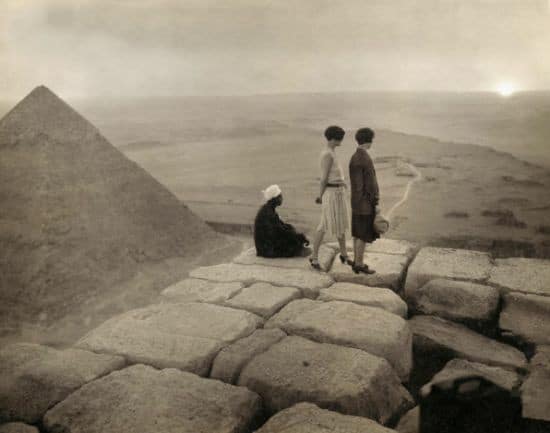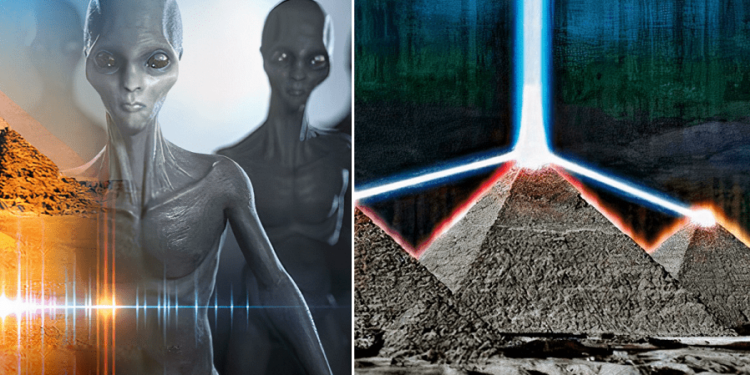Climbing to the summit of Giza pyramids is prohibited due to safety regulations. One of the main reasons that an individual should avoid going to the top of the pyramids is the incredible energy surge. A few researchers claimed to have experienced an unnatural electric phenomenon on their visits to the pyramids’ top. Though it is illegal now, what they have discovered hints at the advanced knowledge of electricity in ancient Egypt.
Is there any truth to “pyramid power”? Does the shape, size, and/or orientation of the structure imbue it with mystical powers? In the late 1800s, a British inventor named Sir William Siemens made it to the flat, settled top of the Great Pyramid of Giza. Christopher Dunn wrote in “The Giza Power Plant: Technologies of Ancient Egypt,” that Siemens experienced a strange energy phenomenon at the Great Pyramid when an Arab guide drew his attention to the fact that, while standing on the summit of the pyramid with his hands outstretched, he could hear a sharp ringing noise. Raising his index finger, Siemens felt a prickling sensation.

Reportedly, Siemens’ Arab guides were not too happy with their tourist’s experiment and accused him of practicing witchcraft. Peter Tompkins wrote: “One of the guides tried to seize Siemens’ companion, but Siemens lowered the bottle towards him and gave the Arab such a jolt that he was knocked senseless to the ground. Recovering, the guide scrambled to his feet and took off down the Pyramid, crying loudly.”
What kind of natural phenomena on the top of the Great Pyramid could produce such an electro-static effect? It would be interesting to conduct additional physics experiments on the top of the Great Pyramid.
In the 1920s, Antoine Bovis, a Frenchman, visited the Great Pyramid and saw the mummified remains of small animals in the King’s Chamber. When he examined the bodies, he discovered they had no odor and, in spite of the humidity in that place, the bodies were dehydrated.
Bovis returned to France and built a wooden model of the Great Pyramid. He aligned it north-south and put a recently deceased cat inside. Within a few days, the cat got mummified. He experimented with other animals, meat and eggs, and reported that all of them were hot dehydrated, and mummified rather than decaying.
Jean-Paul Buquet translated Bovis’ “EXPOSÉ.” Paul wrote: “When they [pyramids] are lit, one can find on the ground a few meters (feet) from their bases straight-lined radiations that may lead to think that they were built like the Menhirs, to mark the crossing of underground sources (Not proven!!!). This fact would be a curious one, because it would mean 4 underground sources intersecting at a 90° angle, composing a rectangle with every pyramid at its center; until disproved, [Bovis] I attribute the radiation lines to being caused by cosmic waves reflected by each side, the experiments I have conducted in the laboratory appear to confirm this supposition.”
According to Nikola Tesla, pyramids served a higher purpose than just mesmerizing giant stone sculptures. Throughout his life, he investigated pyramids and found some alluring things about them. He wondered if they were not giant transmitters of energy: a thought that coincided with his investigation into how to send energy wirelessly.
In 1905, Tesla filed a patent in the U.S. titled “The art of transmitting electrical energy through the natural medium,” outlining designs for a series of generators around the world that would tap the ionosphere for energy collections. He saw planet Earth itself, with its two poles, as a giant electrical generator of limitless energy. His triangle-shaped design became known as Tesla’s electromagnetic pyramid.
He explained that the location of the Egyptian pyramid was responsible for the power. Bigthink wrote: “He [Nikola Tesla] built a tower facility known as the Tesla Experimental Station in Colorado Springs and Wardenclyffe Tower or Tesla Tower on the East Coast that sought to take advantage of the Earth’s energy field. The locations were chosen according to the laws of where the Pyramids of Giza were built, related to the relationship between the elliptical orbit of the planet and the equator. The design was intended for wireless transmission of energy.”
Tesla’s tower was also believed to have been built upon aquifers, which means that the electric technology used by Tesla is nearly identical to that applied in the construction of the Great Pyramid. Both the Great Pyramid of Giza and Tesla’s magnificent Wardenclyffe tower were the systems that generated negative ions and were capable of transmitting them without the need for electric cables, a completely free and wireless energy that powered other electrical components through vast distances.
The eminent astronomer Norman Lockyer wrote about his experiences examining ancient Egyptian sites in The Dawn of Astronomy: A Study of the Temple-Worship and Mythology of the Ancient Egyptians. Searching for evidence that ancient Egyptian laborers had worked by torchlight, he notes that “in all freshly-opened tombs there are no traces whatever of any kind of combustion having taken place, even in the inner-most recesses” (180). Unable to explain the lack of evidence of more elementary light sources, Lockyer recounts how he and his companion joked of “the possibility that the electric light was known to the ancient Egyptians,” noting that the delicate paintwork on the walls of the tombs could not have been completed using natural light reflected from systems of mirrors, as others had previously suggested.
What purpose pyramids served is still not unknown. Some theories claim that they were built as an observatory for inter-galactic communications by the ancient gods.























